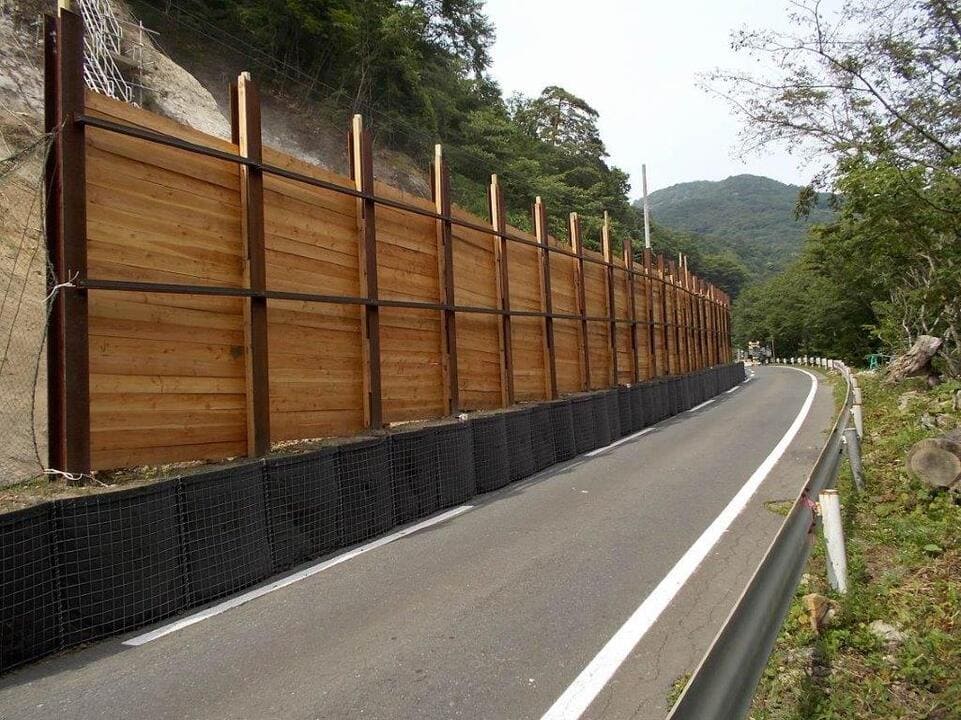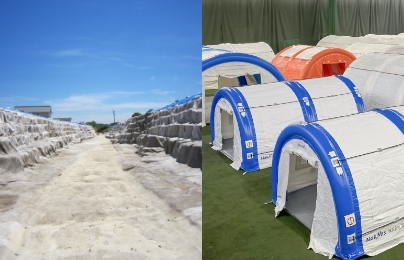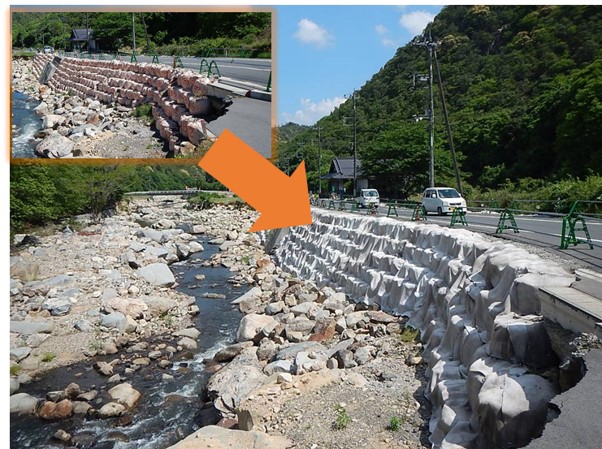

Taiyo Kogyo Column
No need for pile driving, no need for restoration work, no need for underground investigation│Introducing a new construction method for temporary barriers that reduces construction time by 75% and costs by 50%.
2020.10.23

When installing temporary fences to prevent falling rocks from falling onto roadways in service during slope construction along roads, the “Oyashira-Sayabashi” method, in which holes are drilled in the road surface and steel piles are driven into the ground, is commonly used. However, this conventional method has the following problems.
- Large heavy equipment is needed for delivery and construction
- Noise and vibration cause environmental impact in the vicinity
- Narrow streets require two-sided road closures.
- Heavy burden of ancillary works such as underground investigation, overhead line relocation, road surface restoration, etc.
課題を解決して短工期・低コストを実現する新しい工法が、『MWG(メッシュウォールガード)工法』です。
Main features of the MWG construction method
- No piling is required, so the underground deposits are not damaged and the environmental impact, such as noise and vibration, is reduced.
- Possible to use locally generated soil for pillar foundation construction.
- No road surface restoration is required because the road is not damaged at the installation site
MWG工法は、搬入・設置・撤去のコストや工期を大幅に削減します。 MWG工法の利点や特徴を、写真付きの事例を交えて詳しく紹介します。ゼネコン、建設コンサルタント、市区町村の関係者の方はぜひご覧ください。
Outline of MWG Method
MWG工法は、連続箱型鋼製枠に支柱(H型鋼)を立てる仮設防護柵工です。
仮設防護柵は、道路拡幅や法面保護工時に発生する落石の飛散から”車両”や”歩行者”を防護する目的で設置されます。従来工法では、コンクリート基礎の構築やH型鋼杭を地盤へ挿入することで支柱を自立させ、柵を設置しています。
これに対し、MWG工法は『メッシュウォール』という連続箱型鋼製枠内に設置したベースプレートに支柱を固定し、枠内に土砂を投入することで支柱を自立させます。大型重機や特殊作業を必要としない簡単施工が可能で、道路幅が狭くても片側交互通行が可能です。路面の掘削や鋼杭挿入や路面復旧などの工事が一切不要であり、工期とコストを大きく抑えることが可能です。
The design of the WG construction method conforms to the standards set by the Japan Highway Association, and is equal or superior to the conventional method in terms of strength and safety. The height of the structure can be 3m to 5m, and the range of application is the same as that of the conventional construction method.
The MWG construction method has eight major strengths.
- Short construction period
- low cost
- Suitable for narrow roads
- Low noise and vibration
- Can use locally generated soil
- Easy removal
- No prior research required
- No need to relocate overhead lines
I will explain one by one.
Short construction period
The construction period is significantly shortened because large heavy machinery and special work are not required, and incidental work such as underground burial investigation and road surface restoration are not necessary. Compared to conventional construction methods, the construction period can be reduced by up to 75%.
low cost
The amount of steel used is extremely small because there is no need to bury it underground or attach L-shaped supports. Also, since there is no need to insert the steel, no heavy machinery or large vehicles are required, and no ancillary work is needed, which significantly reduces the overall cost of the project.
Suitable for narrow roads
The fact that large heavy machinery and vehicles are not required for construction and that the maximum width of the foundation is only 1.6 m makes construction possible even on narrow sites such as roads between mountains and forests. Even if the road width is narrow, one lane on each side can be secured sufficiently to minimize the load on traffic.
Construction with low noise and vibration
Since construction can be done without the use of pile-driving machines, it requires less noise and vibration than conventional construction methods, and reduces the environmental impact on the surrounding area, thereby giving consideration to nearby residents.
Can use locally generated soil
The special structure of the continuous box-shaped steel frame supporting the support columns allows the use of locally generated soil for filling material. This facilitates construction work by reducing the need to move purchased materials and locally generated soil.
Easy removal
Since it is installed without damaging the road, there is no need to restore the road surface when it is removed.
No prior research required
No prior investigation of underground burial is required, as no steel piles are driven into the ground.
No need to relocate overhead lines
Since no pile-driving machine is used, there is no need to relocate overhead lines. This also contributes to shorter construction period and lower cost.
Comparison of MWG method and conventional method
The following is a summary of the differences between the MWG method and other companies’ similar methods, which involve drilling holes in the road and driving steel piles, or standing on L-shaped steel materials with sandbags or other weights. The most important point is that the MWG construction method can reduce the construction period by up to 75% and cost by 50%. Setting conditions
- Study extension (m): L=100.00m
- Number of days in service: 360 days
- Protection fence height: H=4m
| 施工方法 | ①油圧バイブロハンマー等で地山にH型鋼杭を挿入して支柱を構築する。 ②支柱間を木製横矢板を設置して完成 |
|---|---|
| Estimated direct construction cost (index) | 1.00 |
| Construction days | 28 days |
Other company's similar method: L-shaped steel
| 施工方法 | ①プレートを設置して連続箱型鋼製枠を展開。支柱を建込み、土砂を投入し転圧する。 ②支柱間を木製横矢板を設置して完成 |
|---|---|
| Estimated direct construction cost (index) | 0.48 |
| Construction days | 7 days |
Particularly recommended for this type of person
This method is recommended for general contractors, construction consultants, and municipal officials.
- Urgent disaster countermeasures and other immediate actions are required in areas where slopes have collapsed.
- To solve the problems of conventional construction methods and keep costs lower
- The road width in the area is narrow, but we can’t close it to traffic, so we are in trouble.
If you have such problems and requirements, the MWG construction method can solve them.
MWG Method Application Examples
The MWG construction method has already been utilized and highly evaluated in a variety of situations. Some of the case studies are introduced below.
- Example of slope repair work for the Iwate Prefecture Disaster Prevention Dam Facility Improvement Project
- Example of Iwate Prefecture General National Highway Slope Repair Work
- Nagano Prefecture Disaster Prevention Work
Example of slope repair work at a disaster prevention dam facility
| Location | Iwate Prefecture |
|---|---|
| Specifications | Protective wall height 4.0m, T-1.3 |
| Applications | Temporary protective fences |
| Scale | 90m |
Disaster prevention work
national land enterpriseへの
Contact us
Related Articles
- TOP>
- Taiyo Kogyo Column>
- No need for pile driving, no need for restoration work, no need for underground investigation│Introducing a new construction method for temporary barriers that reduces construction time by 75% and costs by 50%.








